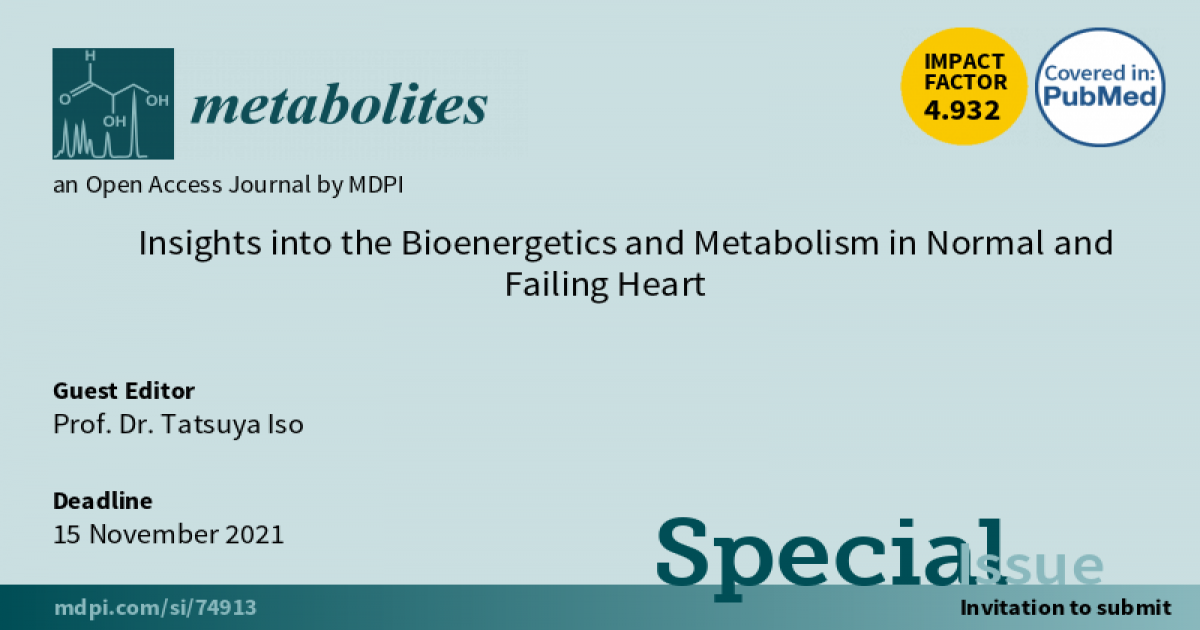Insights into the Bioenergetics and Metabolism in Normal and Failing Heart
A special issue of Metabolites (ISSN 2218-1989). This special issue belongs to the section "Animal Metabolism".
Deadline for manuscript submissions: closed (15 November 2021) | Viewed by 28638

Special Issue Editor
Interests: cardiology; molecular biology; metabolism; heart failure; vascular biology
Special Issue Information
Dear Colleagues,
The heart is the most energy-demanding organ and generates a vast amount of ATP (~6 kg/day) from circulating substrates to carry out its function. The heart is a metabolic omnivore that primarily uses fatty acids (FAs) as energy-providing substrates, with the remaining energy obtained from glucose, lactate, ketone bodies, and amino acids. Preference for these substrates is dynamically changed by substrate availability, hormones, oxygen supply, and cardiac workload. In addition to ATP synthesis (catabolism), energy substrates, especially glucose, are linked to the facilitation of anabolic and accessary pathways, depending on the energy status and pathophysiological situations.
Heart metabolism has long been studied primarily in ex vivo perfused hearts. The major benefits of this approach include simultaneously monitoring the oxidation of energy substrates (catabolism) and controlled hemodynamic parameters, which have provided invaluable assets in the metabolic research of the heart. However, this approach has a weakness in addressing questions related to the metabolic disturbance of the heart in the context of systemic metabolism because isolated perfused hearts have lower oxygen-carrying capacity, regional anoxia due to arteriole constriction, and a lack of neurohumoral feedback. Furthermore, most studies with ex vivo perfused hearts have overlooked the estimation of anabolic and accessary pathways that are invariably accelerated during the progression of heart failure.
Recent advances in metabolic studies have led to the comprehensive profiling of metabolic intermediates through mass spectrometry carried out on in vivo beating hearts. With stable isotopes and calculation of the data, there has been increasing appreciation for the feasibility and importance of tracing the metabolic pathways of major energy substrates in vivo. In combination with other methodologies, such as high-resolution echocardiography, radioisotopes, genome-editing technology, and established heart disease models, we can obtain high-dimensional data of beating hearts to understand the whole picture of both energy catabolism and anabolism. In the Special Issue, we focus on the emerging evidence of metabolic dynamics in normal and diseased hearts, which has recently been analyzed by using in vivo beating hearts. Given that impaired cardiac energy metabolism is a hallmark of heart failure, it is likely that this issue will provide new insight into the mechanism of this disease.
Prof. Dr. Tatsuya Iso
Guest Editor
Manuscript Submission Information
Manuscripts should be submitted online at www.mdpi.com by registering and logging in to this website. Once you are registered, click here to go to the submission form. Manuscripts can be submitted until the deadline. All submissions that pass pre-check are peer-reviewed. Accepted papers will be published continuously in the journal (as soon as accepted) and will be listed together on the special issue website. Research articles, review articles as well as short communications are invited. For planned papers, a title and short abstract (about 100 words) can be sent to the Editorial Office for announcement on this website.
Submitted manuscripts should not have been published previously, nor be under consideration for publication elsewhere (except conference proceedings papers). All manuscripts are thoroughly refereed through a single-blind peer-review process. A guide for authors and other relevant information for submission of manuscripts is available on the Instructions for Authors page. Metabolites is an international peer-reviewed open access monthly journal published by MDPI.
Please visit the Instructions for Authors page before submitting a manuscript. The Article Processing Charge (APC) for publication in this open access journal is 2700 CHF (Swiss Francs). Submitted papers should be well formatted and use good English. Authors may use MDPI's English editing service prior to publication or during author revisions.
Keywords
- heart
- metabolism
- catabolism
- anabolism
- mass spectrometry






